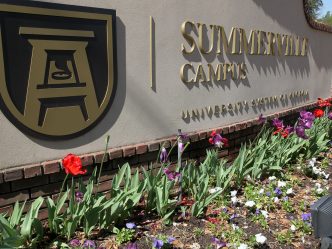The results of the Great Colleges to Work For survey are in. While somewhat outperformed by the overall group of 232 institutions, Augusta University ranked comparably to its peers as well as to Carnegie research institutions. However, university leaders recognize opportunities for improving employee engagement, and they are working with action teams made up of faculty and staff members to develop specific actions using the survey results.
The survey, sponsored by the Chronicle of Higher Education in partnership with ModernThink, a leading organizational development and management consulting firm, serves as a tool for shaping the short-term and long-term goals of Augusta University.
In an effort to achieve more accurate and inclusive results, the decision was made to include all full-time faculty and staff rather than relying on a random sample, and unlike the Press-Ganey survey it replaced, it allows the university to directly see how it stacks up against its peer institutions.
“A real strength of this particular survey is our ability to benchmark our results, not just against other higher education institutions, but also against our peer institutions and institutions in our same Carnegie classification,” said Dr. Gretchen Caughman, executive vice president for academic affairs and provost. “This is important because it allows us to consider not only the local factors influencing our results, but also the broader national context and the common issues we face.”
Built around thematic areas like pride, compensation and teaching environment, the survey gauges employee satisfaction and concerns. In its tenth year, it is acknowledged as one of the leading evaluation tools used by higher education.
The results, available on the provost’s web page, show that faculty and staff consider the work they do important and are proud to do it. Among other things, they appreciate working in a diverse and collegial environment and feel they have supportive supervisors.
Areas identified as needing improvement include promoting collaboration, improving the perceptions of collaboration and shared governance and improving communication between layers of the organization.
“The results identified a number of strengths, which are areas we need to both celebrate as well as continue to support and enhance,” Caughman said. “It also identified a number of thematic areas not viewed as favorably by respondents, which are opportunities for us to acknowledge, discuss candidly and work together to improve.”
Beginning this month, the provost will approve an identified goal that will be adopted as part of each unit’s unit plan. Units – including colleges, administrative units, the University Senate and the Employee Advisory Council – will then identify up to three tactics they can use to achieve this goal. The tactics must be identified by Jan. 15, 2018, and the results will be submitted as part of the FY 18 Unit Planning Assessment Report on July 31, 2018.
“The results of any survey are a snapshot,” Caughman said. “The value of that snapshot is what happens as a result of what we see in it and how, through intentional strategies and activities, we can influence in a positive way what the next snapshot depicts. That is why we must all commit to doing this together.”
In November, University employees will be asked about how they felt about the survey experience in a short follow up survey. Similar feedback was instrumental in the switch from Press-Ganey to Great Colleges.
For a comprehensive look at the survey and its results, visit the Great Colleges to Work For survey section of the provost’s webpage
 Augusta University
Augusta University



